
Dr. Murphy on the influence of genomic testing in prostate cancer

"For those people in the intervention arm who did get the assay, the doctors were more likely to prefer active treatment with surgery or radiation compared to the control group," says Adam B. Murphy, MD, MBA, MSCI.
In this video, Adam B. Murphy, MD, MBA, MSCI, highlights the background and notable findings from the study, “Impact of genomic testing on urologists’ treatment preference in favorable risk prostate cancer: A randomized trial,” for which he served as the senior author. Murphy is an assistant professor of urology at Northwestern University in Chicago, Illinois.
Video Transcript:
Could you describe the background for this study?
This was a study based off of clinical trial we did from 2016 to 2019. It was all in safety net hospitals. It was a unique trial in a few ways, because it was testing the clinical utility of the genomic prostate score, genomics assay. We wanted to see how it affected both patient and provider treatment choices and preferences. That's a first of its kind trial design, we think. The other thing that was unique about it was that it was taking place in safety net hospitals. University of Illinois in Chicago, Cook County Health and Jesse Brown VA. So, it was a pretty unique study in that way. It was a randomized control trial. We were providing level 1 evidence of what the impact of this this assay would be on providing treatment preferences. This comes in the backdrop of retrospective data saying that these assays helped providers increase their uptake of active surveillance. Because at the time, active surveillance was growing in popularity, it was not quite as arrived as it is now. People have real concerns about whether they should be doing active surveillance in African American men, so the other part of our study that's interesting is that it's about 70% Black patients enrolled in the population.
What were the notable findings from this study?
A couple of notable findings were that the assay did seem to increase urologists' preference for active treatment with surgery or radiation relative to active surveillance uptake. Overall, this study showed that there was increased active surveillance uptake across our whole study compared to what the general population of urologists were preferring. Patients definitely received active surveillance at a really high rate in this trial compared to the national average, which is about 44%. We were at about 80% for this study for active surveillance uptake. For those people in the intervention arm who did get the assay, the doctors were more likely to prefer active treatment with surgery or radiation compared to the control group.
This transcription has been edited for clarity.
Newsletter
Stay current with the latest urology news and practice-changing insights — sign up now for the essential updates every urologist needs.


















